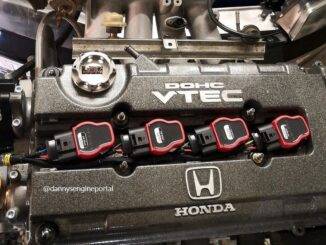
Crankshaft position sensors (CKP) read ignition timing, the (RPM) signal, and determine engine speed.
But, when the crankshaft position sensor (CKP) fails, it stops transmitting the readings.
Consequently, the crankshaft position sensors (CKP) readings, contain the vital data for the ignition and other parts in the system.
So, the engine computer takes the data from both, the crankshaft position sensor and the camshaft sensor. Then, uses that data, to assess how the engine is operating.
Furthermore, the speed and position of the crankshaft, are two key parameters that the car’s computer uses. Most importantly, for engine management calculations.
A Bad Crankshaft Position Sensor (CKP), Can Cause Faults Such As:
- Engine idling erratically
- Failure to start
- Poor starting
- Flat acceleration
- Engine misfiring
- Excessive engine vibration
- Backfiring
So, if you are having problems starting your car, it could be a bad crankshaft position sensor (CKP).
Sensor Location
The (CKP) sensor will be located at the lower section of the engine block. And, can either be at the front, rear or middle of the engine. But, always at the crankshaft level.
Sensor Testing
So, you have finished testing your (CKP) sensor, and you have determined that it has indeed failed.
If you need more help on testing and troubleshooting, read our related blog posts:
- Crankshaft Position Sensor Failure Symptoms
- Crankshaft-Camshaft Position Sensor
- Crankshaft-Camshaft Position Sensor Testing Made Easy
Basic Steps To Replace A Crankshaft Position Sensor (CKP)
With a good set of instructions, the right tools, and some effort, you can replace your crankshaft position sensor (CKP) yourself.
Safety First – Always Wear Protective Gloves and Eyewear.
Step 1, Disconnect The Battery ( Before you start you need to read about the battery )
Because, this ensures there will be no accidental shocks, that could injure you and damage the car’s electronics.
Step 2, Prepare Access To The Work Area
Firstly, jack the vehicle up high enough, to obtain access to the (CKP) sensor. Then, secure the vehicle in this position, using jack stands. You may have to remove some other parts, before you can reach the (CKP) sensor. In short, take out anything that’s getting, in between you and the (CKP) sensor.
Step 3, Disconnect The Electrical Connector
So, the crankshaft position sensor (CKP) uses a plastic clip, which you must push down or pull outward to release. Once this is done, gentle wiggle the connector loose from the (CKP) sensor. Once the connector is removed, check it for rust and clean or replace the pigtail if needed. Since, this problem alone, will cause the engine to stall.
Step 4, Remove The Sensor Mounting Bolt
The (CKP) sensor is typically held in place with, one or two 10mm bolts. Gently but firmly, twist and pull the (CKP) sensor, to remove it from the engine.
Step 5, Remove The (CKP) Sensor
Gently but firmly, twist and pull the (CKP) sensor, to remove it from the engine. Sometimes removing the (CKP) sensor, can be a little difficult. Because, they can get stuck in the block. So, if the (CKP) sensor doesn’t slide out easily, you may have to pry it out. A door panel clip removal tool, can actually be helpful here. Be careful, not to apply too much pressure. Because, these (CKP) sensors have been known to break.
What Are your Choices If It Breaks:
- So, if it does break, you may have to remove the oil pan, and pry it out, from the inside.
- Optional Tip– Drill a small hole in the center of the (CKP) sensor, if there is none. Get a small lag bolt that fits the hole. Use JB Weld or a similar product on the thread of the bolt. Screw it in and let dry. Again, use a small pry bar and wiggle it out. This may save you from, removing the oil pan. (GOOD LUCK)
Step 6, Prepare The O-Ring
Lightly lubricate the O-ring that is on the new (CKP) sensor, to make it easier to install.
Step 7, Install The New (CKP) Sensor
Before installing the new (CKP) sensor, use a clean rag to clean, the crankshaft position sensors port hole. You can spray cleaner on the shop towel, to aid the cleaning process. Position the new (CKP) sensor, squarely into the sensor port hole. Then, firmly push it into place. Next, insert the mounting bolt and thread it in by hand, by turning it clockwise, to avoid cross threading. After the (CKP) sensor has been installed, thread the mounting bolt into place and tighten, to about 2-3 foot pounds.
Step 8, Re-Connect The Electrical Connector
Plug the new crankshaft position sensor (CKP), into the engine wiring harness. Also, make sure that the connector clip, is engaged all the way on the (CKP) sensor. Then, you just need to replace any parts, you removed to access the (CKP) sensor.
Step 9, Lower The Vehicle
Now, carefully remove the jack stands and lower the vehicle.
Step 10, Connect The Battery
Finally, re-connect the negative battery cable, and you are good to go.
Conclusion
So, a failing or failed crankshaft position sensor (CKP), may cause the check engine light on your dashboard to come on. Furthermore, a diagnostic scan tool will show a code, between P0335 and P0338. Above all, the crankshaft position sensor (CKP), is critical to proper engine performance. Finally, when they have issues, they can quickly lead to problems that affect the drivability of the vehicle.
BY DANNY BENDER




